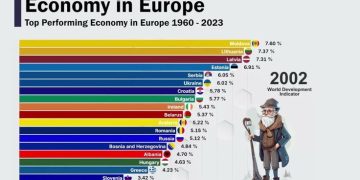The Rise of Asia as the Next Global Financial Center
1. Introduction: A Global Power Shift in Finance
For decades, the world’s financial landscape has been dominated by Western economies—New York, London, and Frankfurt. But in the past twenty years, and especially after the pandemic reshaped global economic dynamics, the center of financial gravity has been shifting steadily eastward.
Asia—driven by the combined economic weight of China, Japan, South Korea, Hong Kong, Singapore, India, and the rapidly emerging economies of ASEAN—is transforming into the world’s most dynamic financial region. This shift is not superficial; it is deep, structural, and reshaping global capital flows, monetary strategy, currency competition, and regulatory frameworks.
By 2030, Asia is projected to account for:
- Over half of global GDP growth
- More than 50% of global financial assets under management
- The world’s largest middle-class consumer market
- The highest digital payments volume globally
Asia is not only growing larger but also more integrated, more technologically advanced, and more influential in global financial governance.
This article explores how Asia is rising as the next global financial center—driven by capital markets, monetary policy, digital finance, cross-border investment flows, and geopolitical realignment.
2. The Economic Foundation of Asia’s Financial Rise
2.1 Asia’s Rapid Economic Expansion
Asia’s rise is underpinned by powerful macroeconomic fundamentals. Over the last three decades, Asia has consistently outperformed all other regions in GDP growth. According to IMF and World Bank projections, Asia will contribute nearly 70% of global economic growth between 2024 and 2035.
China, India, and ASEAN are the main engines:
- China remains the world’s second-largest economy, with deepening financial reforms and rising global influence.
- India is becoming the fastest-growing major economy, supported by an expanding workforce and large-scale digitalization.
- ASEAN economies—Indonesia, Vietnam, Thailand, Malaysia, and the Philippines—are emerging as new industrial centers and global value chain hubs.
The economic scale itself forms a natural foundation for a global financial power center.
2.2 Urban Hubs Turning Into Global Financial Cities
Asia hosts some of the world’s most important and fastest-growing financial hubs:
- Singapore: Now the world’s largest foreign exchange center after London and New York.
- Hong Kong: A gateway for Chinese capital, equity markets, and RMB internationalization.
- Shanghai: One of the world’s largest stock markets by market cap.
- Tokyo: A traditional financial powerhouse undergoing renewal with new policy reforms.
- Mumbai: Rising rapidly on the back of India’s economic growth.
- Seoul: A growing center for fintech, digital assets, and corporate financing.
Each of these hubs plays a different role, but together they form an interconnected financial ecosystem unmatched by any other region.
3. Asia’s Capital Markets: Bigger, Deeper, and More Global
3.1 Explosive Growth of Stock and Bond Markets
Asian capital markets have grown rapidly in depth, liquidity, and global relevance.
- China’s stock markets (Shanghai + Shenzhen) are now among the world’s largest, surpassing Japan and approaching U.S. levels in trading activity.
- India’s stock market became the world’s fourth largest in 2024, fueled by rising domestic investors.
- ASEAN capital markets are modernizing at unprecedented speed.
On the bond front, Asia has become a central hub for sovereign and corporate debt:
- China is the world’s second-largest bond market.
- Japan remains one of the world’s deepest fixed-income markets.
- Asian green bonds represent over one-third of global issuance.
3.2 Foreign Investment Is Shifting East
Global asset managers are reallocating a growing share of their portfolios toward Asia.
- Sovereign wealth funds from the Middle East are increasing investments in Asia.
- European pension funds are raising exposure to Asian infrastructure and green finance.
- U.S. institutional investors are expanding in India and Southeast Asia as China adjustments continue.
Asia’s demographics—young, growing, and digitally active—make it an irresistible destination for long-term capital.
4. Currency Power Shift: The Asian Currency Era
4.1 The Renminbi’s Gradual Rise
Although the U.S. dollar dominates global finance, Asia is pushing currency diversification.
The Chinese RMB has become:
- The fifth most-used global payments currency
- A major currency for central bank reserves
- The dominant settlement currency for China–ASEAN trade
- The most active currency in central bank digital currency (CBDC) development
RMB usage is rising fastest in energy and commodities trade—especially with the Middle East.
4.2 The Yen and Won in a New Monetary Environment
Japan and South Korea are also influencing regional liquidity through:
- Monetary policy adjustments
- Active bond markets
- Growing role in digital payments and settlement systems
The yen’s weakness has boosted Japanese exports and investment abroad, while the won benefits from Korea’s technological strengths.
4.3 De-dollarization in Asia
Asia is not attempting to replace the dollar—but it is reducing dependence.
Regional currency arrangements include:
- CIPS (China’s alternative to SWIFT)
- ASEAN local currency cross-border payment systems
- BRICS expansion
- RMB-based oil and gas settlements
This multi-currency landscape strengthens Asia’s financial autonomy.
5. Digital Finance: Asia Leads the World
5.1 Digital Payments at Global Scale
Asia processes more digital payments than any other region.
- China’s mobile payments market exceeds those of the U.S. and Europe combined.
- India’s UPI is becoming a global standard for low-cost instant payments.
- Southeast Asia has over 500 million digital consumers.
5.2 Fintech and Digital Banks
Asia has the highest success rate for fintech startups, including:
- Digital banks in Singapore, South Korea, and Hong Kong
- Super-app payment ecosystems in China and Indonesia
- Cryptocurrency innovations in Japan and Singapore
The region is setting regulatory and technological standards for global finance.
5.3 CBDCs and Digital Monetary Systems
Asia is far ahead in central bank digital currency development:
- China’s e-CNY is the world’s most advanced CBDC.
- India, Japan, and South Korea are piloting digital currency platforms.
- ASEAN is testing cross-border CBDC settlements.
These innovations are reshaping how money moves globally.
6. Asia’s Geopolitical Advantage in the Financial Era
6.1 Middle East × Asia: The New Financial Corridor
Energy capital is flowing eastward:
- Saudi Arabia, UAE, and Qatar are increasing investments in China and India.
- Asian economies are becoming the largest buyers of Middle Eastern oil and gas.
- New financial alliances (BRICS+, SCO, ASEAN+3) support cross-border investment.
6.2 Supply Chain Realignment
Asia’s “China + Southeast Asia + India” production triangle is becoming the world’s dominant manufacturing system.
Financial flows follow supply chains—leading to a surge in:
- Project financing
- Corporate credit
- Cross-border M&A
- Sovereign wealth fund participation
6.3 Regional Stability and Long-Term Opportunity
Despite tensions, Asia’s long-term stability and economic momentum remain strong.
7. Challenges: Can Asia Really Become the Global Financial Center?
Asia faces major obstacles:
7.1 Political and Geopolitical Risks
U.S.–China strategic competition, territorial disputes, and regional security issues create uncertainty.
7.2 Regulatory Fragmentation
Asia is diverse—financial regulations differ widely across countries.
7.3 Transparency and Governance Gaps
Some Asian economies still lag in:
- Corporate transparency
- Investor protection
- Legal enforcement
7.4 Capital Controls
China and India maintain varying degrees of capital controls that limit full financial liberalization.
7.5 Demographic Challenges
Japan, South Korea, and China are aging rapidly, posing long-term macroeconomic challenges.
However, these challenges are not enough to derail Asia’s financial rise—they simply shape the pace and nature of the transition.
8. Conclusion: Asia Will Become the Heart of Global Finance—Not If, But When
Asia’s rise as a global financial center is no longer speculation—it is an unfolding reality.
The region’s transformation is powered by:
- Massive economic scale
- Fast-growing capital markets
- Technological leadership in digital finance
- Increasing currency influence
- Strong cross-border investment flows
- Deepening regional integration
- Geopolitical realignment toward the East
While structural challenges remain, the long-term trajectory is clear:
The global financial center of the 21st century will be in Asia.
Not centered on one city, but a network:
Singapore + Hong Kong + Shanghai + Tokyo + Mumbai + Seoul + the ASEAN cluster.
Together, they form the world’s most dynamic, interconnected, and rapidly evolving financial ecosystem.

































